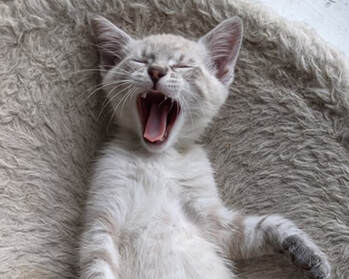
To ease the discomfort of teething, kittens are notorious for nibbling and chewing, chomping and biting on anything within reach of their tiny paws – including your fingers and toes.
Kittens invariably begin to lose their baby teeth at around the age of nine weeks, while their adult teeth won’t have grown in fully until they’re between five and six months old. What more purr-fect time then, for every pet parent to teach their kitten some early “table” manners, i.e., what is and what isn’t appropriate when it comes to chewing and biting.
Consider the five following suggestions to make your new life together ever so much easier.
1. Once solely a doggy’s domain, chew toys are now fabulously feline friendly. Manufacturers, near and far, produce toys specifically designed to provide appropriate “targets” for those budding kitten teeth. Choose from a vast array of these treasures ranging from cloth toys that can be chilled to ease your kitten’s tender gums and firmer chews that will exercise her jaw muscles to nylon-based toys made expressly for teething.
2. Discover the wonders of interactive playtime and integrate it into your own daily routine. Why, you may ask? Every teething – and growing -- kitten requires vigorous, interactive play because it not only helps her work off excess energy, it also helps develop her balance and build up her strength. Using one or more of a variety of specially designed teaser toys at least twice a day for 10 to 15 minutes each time will both give your kitten a suitable object for her chewing and reinforce the growing pet-parent bond between you.
3. Of utmost importance: whenever you’re petting your kitten, make certain to keep your hands away from her mouth. Follow this same rule when playing with her. Never use your fingers as objects she can all too easily and confusedly consider fair game for her teeth. No mixed signals, paw-lease!
4. Be prepared to use the word “Ow!” if your teething kitten happens to bite you. Why? Because whenever the play between two cats becomes too rowdy or rough, the victim will emit a high-pitched cry, causing the aggressor to back away, and, ultimately flee. Say “Ow!” in a high-pitched but not overly loud voice, then promptly put your biting kitten on the floor. Referred to as the “Ow” and Down” technique, using it consistently will teach your wayward kitten that biting on her part means no playing or petting on your part.
5. Always ensure that, wherever you are, you have several chew toys close by. This way, if you’re sitting with your teething kitten and notice her expression suddenly signal, “I’m in the mood to bite something,” you can swiftly hand her a teething-appropriate toy, thereby taking your fingers safely off the proverbial menu.
In short, by lovingly, patiently and consistently reinforcing the message that only certain items are reserved for your teething kitten’s nibbles and chews, chomps and bites, you’re paving the way for the most purr-fect of futures together.









 RSS Feed
RSS Feed